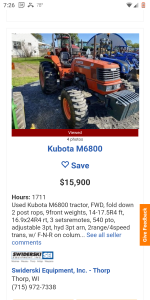5030
Epic Contributor
- Joined
- Feb 21, 2003
- Messages
- 28,967
- Location
- SE Michigan in the middle of nowhere
- Tractor
- Kubota M9000 HDCC3 M9000 HDC
Like I said earlier, the Achilles Heel on Kubota's (at least the M series that I own is the wimpy clutch brake. It's only 1 set of plates in the hydraulic pto assemble and it's pretty darn easy to to ruin them by running any implement (like a shredder) for instance that has no built in over running clutch. When the pto is off but the implement is freewheeling the tractor pto stub, it's eating up the pto brake. Simple solution is of course to add an over running clutch (ratchet one way clutch) to the pto stub on the tractor. That way, when you disengage the pto at speed, the freewheeling implement pto shaft won't be turning the stub shaft and destroying the pto brake.
I understand from my dealer that Kubota has/had a service bulletin on it at one time but mine are so far out of warranty it don't matter and accessing the pto clutch pack entails splitting the tractor anyway.
Just as easy to add an over running clutch, just be sure the over running clutch you buy is rated for your tractor pto power. TSC sells them and they are on Flea Bay as well. Because my M's have a pretty high pto output power, I had to buy a heavy duty over running coupler but the one I have fits both tractors. The one I have is 6 spline male on one end and 6 spline female on the other. It does increase the stub length about 4" so you might have to shorten the input shaft to the implement accordingly.
Pretty easy to tell if the pto brake is shot. Just grab the pto stub with your hand (with the engine off) and turn it. If the brake is working correctly, the stub shaft will rotate about half a revolution and stop. If the brake is shot, the stub shaft will rotate with no stopping.
The other issue with a worn pto brake is, the stub shaft will continually rotate whether the pto is engaged or not and that is because it's a wet clutch (pto) and there is a certain amount of parasitic drag from the wet plates.
I understand from my dealer that Kubota has/had a service bulletin on it at one time but mine are so far out of warranty it don't matter and accessing the pto clutch pack entails splitting the tractor anyway.
Just as easy to add an over running clutch, just be sure the over running clutch you buy is rated for your tractor pto power. TSC sells them and they are on Flea Bay as well. Because my M's have a pretty high pto output power, I had to buy a heavy duty over running coupler but the one I have fits both tractors. The one I have is 6 spline male on one end and 6 spline female on the other. It does increase the stub length about 4" so you might have to shorten the input shaft to the implement accordingly.
Pretty easy to tell if the pto brake is shot. Just grab the pto stub with your hand (with the engine off) and turn it. If the brake is working correctly, the stub shaft will rotate about half a revolution and stop. If the brake is shot, the stub shaft will rotate with no stopping.
The other issue with a worn pto brake is, the stub shaft will continually rotate whether the pto is engaged or not and that is because it's a wet clutch (pto) and there is a certain amount of parasitic drag from the wet plates.


